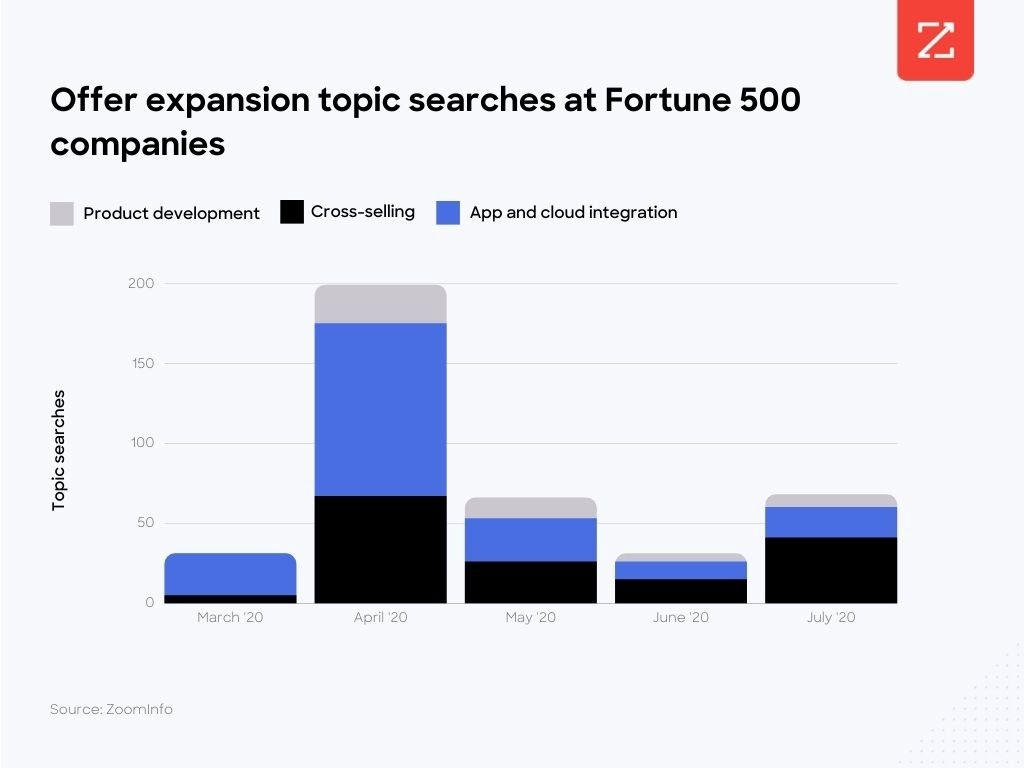Interesting tidbit: The probability of selling to a new prospect is 5–20%. The probability of selling to an existing customer is 60–70%.
In 2020, with businesses in turmoil, many have shifted to focus on growing accounts by upselling more services and cross-selling new product lines. Repeat and loyal customers are more critical to a company’s success than in financially stressful periods. Just ask the likes of Airbnb, Spotify, Peloton, Slack, Zoom, and more — who have maintained (and even grew) brand loyalty through meaningful product expansion strategies while working today’s mostly remote work environment to their advantage.
In order to cross-sell to existing customers, companies in 2020 have launched more new products than in each of the prior two years, with an uptick in launches continuing steadily, albeit a significant increase in “product launch” mentions at the height of the pandemic.

From March to July, web searches at Fortune 500 companies for cross-selling surpassed those for product development by nearly four to one, and integrations had three times the searches compared to product development.
“Driving revenue by retaining existing customers is the name of the customer success game,” according to HubSpot. “And strategies that can drive even more — like cross-selling and upselling — have huge ROI.”
Product expansion through cross-selling and upselling
But first, what’s the difference?
Unlike the more straightforward art of selling, cross-selling and upselling are nifty little strategies that can sneak up on you seemingly out of nowhere. Done right, they are stealthy value-providers that buyers gravitate toward through pre-established brand trust. Done wrong, these strategies can seriously vex your prospects and customers and negatively impact your brand through perceived irrelevance and what can come across as a plan to “push more product for the sake of pushing more product.”

Upselling: A sales technique that pitches customers a more costly product or service, and/or presents them with upgrades or add-ons — facilitating a more expensive business model. In other words, “Would you like to Super Size that?” The goal: account growth.
Today, the hospitality industry is especially reliant on upselling through either in-person or by means of various software. Hotels, mostly prior to guest arrival, aim to both uplevel customer experience and boost revenue through upgrade options that include such à la carte items as early check-ins, room upgrades, access to exclusive services and facilities, and so on. The pandemic hit this particular industry hard, and transparent upselling is one path forward to a win-win on behalf of the business and the customer.
Cross-selling: This one’s a little more tricky; the technique occurs when the seller offers its customer a product or service from an alternative product or service category. The offering is usually related to the customer’s original purchase (think, “Would you like fries with that?), but can also be one that’s quite out of left field. The goal: introduce the customer to another category within your business.
To cross-sell effectively, companies must offer products or services that naturally pair well and are often similar in price points, like fries and a burger or coffee and donuts. Or, carbs aside, they have to get really creative in their offering(s); all’s fair game as long as the customer deems the expansion efforts valuable.
This year, Finnair took a creative approach to cross-selling when they announced they would sell its airplane food in shops. But I hate airplane food. In this case, however, you might feel differently — depending on your palate — given that this particular menu includes the likes Arctic char, Japanese-style teriyaki beef, roasted carrots with blue cheese. Not too shabby.

The cross-sell comes as airlines around the world “try to employ their idled resources during the pandemic and tap into people’s desire to fly when most planes are grounded.” The move, done effectively, will make Finnair some money and reinvigorate wanderlust — hopefully sustaining some brand loyalty for that one day we can fly again in the process.
2020: The year of product expansion?
Strategies like cross-selling and upselling are central components of ZoomInfo’s go-to-market (GTM) framework. The model is designed for companies first to select the GTM phase they’re operating in and then choose the right course of action to successfully execute that phase.
The offer expansion quadrant, specifically, primes companies to broaden their products or services and bring in more revenue through various strategies that can include maintaining customer loyalty and brand “stickiness” — crucial in unprecedented times. Because today, more than ever, every loyal customer can make a measurable impact.

The thing is, while acquiring new customers is undoubtedly important — especially so for investors building value for venture-backed companies — it’s the considerably harder path to take in tenuous times. The shift to placing bigger more on the current customer, therefore, is necessary.
What’s next?
Clearly, product expansion is thriving in even the most challenging of times. It’s reasonable to surmise that the pandemic, at least in part, is driving the need for businesses to increase customer loyalty through — in many cases — creative, timely, and useful cross-selling and upselling initiatives.
Businesses doubling down on these tactics during COVID-19 are hoping to inject some sense of control into an environment that’s otherwise highly unpredictable. Is it working? So far, maybe.

